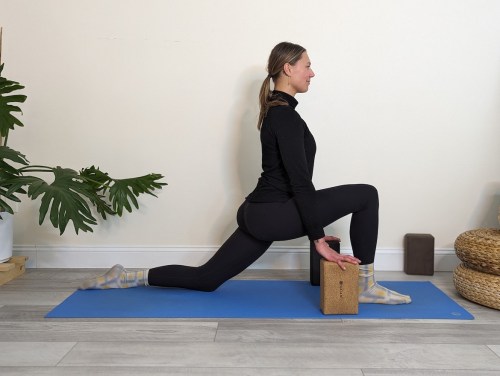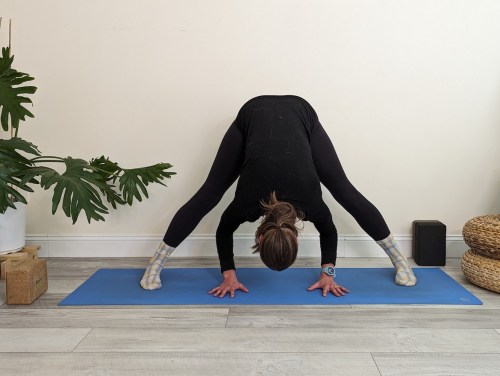The 5 Best Yoga Poses to Relieve Lower Back Pain
Explore yoga for lower back pain relief. Discover effective poses to ease discomfort and enhance your overall spinal health.

Statistically speaking, there’s a good chance you or someone you know has experienced back pain. In fact, back pain is one of the most common reasons why people see a doctor or miss work, according to the National Institute of Neurological Disorders and Stroke.
Experts in This Article
physical therapist and yoga teacher
While severe back pain can certainly keep you homebound—or at least horizontal for a bit—there’s a wide spectrum of back pain that can crop up as anything from nagging aches and pains to more serious chronic conditions that can take a toll on your body and mind.
But there are plenty of reasons to remain optimistic if you experience back pain—chief among them is the benefit of utilizing a safe and supportive yoga practice to relieve that pain.
“Movement is medicine,” says Lindsay Mayock, DPT, a physical therapist and yoga teacher who employs yoga to treat her patients.
The question is, exactly what kind of yoga is best for lower back pain relief and can it really help? Ahead, we’ll answer all those questions and more. So roll out your yoga mat and keep reading!
Is it safe to do yoga with lower back pain?
Although back pain is complex and unique to every individual, the short answer is yes, it’s safe to do yoga with lower back pain. In fact, Mayock says she’s seen many of her patients “finally get out of chronic back pain through yoga”.
“In my view as a physical therapist who uses yoga for back pain a lot, it can strike a really nice balance of both stability and mobility,” Mayock says.
While it’s always best to see a specialist to provide a correct diagnosis and treatment plan for your back pain, a gentle yoga practice can bring the relief, stretch, and strength you need to move toward feeling better. But don’t push yourself too far.
“It’s safe to move through ranges of motion that are available to you, and yoga can help build that range of motion,” Mayock says. “The practice will have to be tailored to the person. This is where a specialist is great because back pain can be more nuanced, so sometimes it’s important to get the pain under control first before doing yoga.”
The benefits of yoga for lower back pain
The fundamentals of yoga poses are also some of the best tools to manage and treat back pain: mobility, stability, and deep breathing.
“From a physiological perspective, yoga is dynamic and strengthening, which are really good for pain of any sort,” Mayock says.
Even though pain or tension can be the most obvious sensations you experience with back pain, weak muscles are correlated with tight muscles, which can be a common underlying issue that perpetuates the pain cycle. And, the biggest physical benefits of doing yoga are the big stretch and increased muscle tone for better, all-over support.
How to reduce lower back pain with yoga
When it comes to managing—and ultimately reducing—back pain of any kind, the best tool in your yoga toolbox is your breath. Along with seeking professional support and using mindful movement to improve strength and length in your muscles, deep diaphragmatic breathing (or belly breathing, as it’s sometimes called) is a powerful way to bridge the gap between body and mind.
“When people are in pain, their breath gets shallow, which amplifies the stress response,” Mayock says. “Coming into a deeper breath is going to calm the nervous system and increase those healthy hormones that help to treat pain from within.”
“It’s safe to move through ranges of motion that are available to you, and yoga can help build that range of motion.” —Lindsay Mayock, DPT
The best yoga poses for lower back pain
1. Child’s pose (Balasana)
With many points of contact on the floor, your spine in neutral, and gravity to assist your entire body into a supported rest, child’s pose is a great starting point to connect with body and breath when experiencing back pain.
It also provides a hip and lower back stretch without doing any extreme movement. (If you need an even gentler option, check out these child’s pose modifications!)

- 1.Begin on your hands and knees in tabletop position and take a deep breath in.
- 2.Exhale and sink your hips back onto your heels, spreading your knees wide enough apart to fit your torso between your thighs.
- 3.Inhale and reach your arms forward to lengthen your spine.
- 4.Exhale and relax your entire body down into the floor.
- 5.Stay here for 3 to 5 rounds of breath, or as long as 5 minutes.
2. Low lunge with yoga blocks (Anjaneyasana)
The low lunge stretches your front hip muscles, lengthens your psoas muscle (the deep core muscles that connects your spine to your pelvis), and invites in a very low-intensity balance challenge to build core strength and stability.
Using yoga blocks offers more support in this pose, but feel free to put your hands on your hips and not use the yoga blocks for balance if you want more of a challenge.

- 1.Begin on your hands and knees in tabletop position. Place each hand on top of a vertical yoga block.
- 2.Press your hands into the blocks and step your right foot forward to the top of your mat.
- 3.Bend your right knee to a 90-degree angle.
- 4.Squeeze your inner thighs toward each other to stabilize your pelvis.
- 5.Inhale to elongate your spine.
- 6.Stay in the pose for 3 to 5 rounds of breath, then switch sides and repeat.
3. Side plank modification (Vasisthasana)
This modified side plank pose elongates the side of your body to create space in your spine, while the balancing aspect builds strength and stability along the underside of your body. It can also open up your chest and help tone your upper back.

- 1.Begin on hands and knees in a tabletop position.
- 2.Keep your left hand and left shin down on the mat as you inhale and open up your chest, lift your right arm, and stretch your right leg back and down onto the floor.
- 3.Exhale and press your bottom leg and hand down to stabilize your body.
- 4.Inhale and stretch your top arm alongside your top ear.
- 5.Stay here for 3 to 5 breaths, then repeat on the other side.
4. Standing wide-legged forward fold (Prasarita Padottanasana)
Decrease pressure on your spine while you release your hamstrings and inner thighs in a standing wide-legged forward bend. This pose is a wonderful way to gently draw your spine down for more space and length, with the added benefit of calming your nervous system.

- 1.From a standing position step your feet about 3 to 4 feet apart.
- 2.Inhale to elongate your spine and exhale as you bend forward at tyour hips and let your head and arms hang gently.
- 3.Press your palms into the mat. (You can place your hands on yoga blocks instead of on the mat if needed.)
- 4.Gently press your feet down into the mat for stability.
- 5.Stay here for about five rounds of breath.
- 6.Place your hands on your hips to slowly return to standing.
5. Legs up the wall pose (Viparita Karani)
The ultimate pose for relaxation, legs up the wall pose rejuvenates your legs, hips, and entire torso by providing whole-body support. However, it does bring your spine into a slight backbend, so you can counter this by grabbing hold of opposite elbows overhead to keep a neutral spine and lengthen the side of your body and psoas muscles.
Tip: You can also place your legs up on a chair if a wall is unavailable.

- 1.Place your yoga mat perpendicular to a wall and sit with your left side against the wall.
- 2.Gently turn your body to the left and carefully swing your legs up the wall.
- 3.Lower your back to the floor and lie down. Rest your shoulders and head on the floor.
- 4.Inhale and grab opposite elbows overhead and exhale to relax your body completely.
- 5.Take deep breaths into your belly and long, slow exhalations to calm your nervous system.
- 6.Stay here for 1 to 5 minutes.
FAQ
1. How often should you do yoga if you have lower back pain?
Mayock recommends doing the gentle yoga stretches for back pain above three to five times per week, or as needed.
“They’re meant to provide relief,” Mayock says. “So, do them when you need relief.”
2. Should I do yoga if my lower back hurts?
Yoga and diaphragmatic breathing can be a great remedy, as long as the pain isn’t too great.
“Movement is really medicinal for back pain,” Mayock says. “Yoga can be a part of it, but the question is more nuanced.”
Start by practicing gentle poses that feel accessible to you, and always exit a pose—and loop your doctor or physical therapist in—if you feel pain.
3. Which yoga poses aren’t good for lower back pain?
Because not all back pain is the same, there’s a wide variety of yoga poses that can be helpful or harmful depending on the nature and severity of your back pain. However, gentle yoga poses that don’t take you to any extreme movement can help release tension and build strength that is useful for reducing back pain.
4. How long does yoga take to fix lower back pain?
Back pain is individual and complex, according to Mayock, so there’s no specific amount of time you can count on your back pain disappearing.
However, you can use yoga and (and medical treatment) to learn more about your body and the pain, so that you can “empower yourself to be able to go into a yoga class and make the modifications you know you need,” Mayock says. “It’s a management process.”
Sign Up for Our Daily Newsletter
Get all the latest in wellness, trends, food, fitness, beauty, and more delivered right to your inbox.
Got it, you've been added to our email list.










